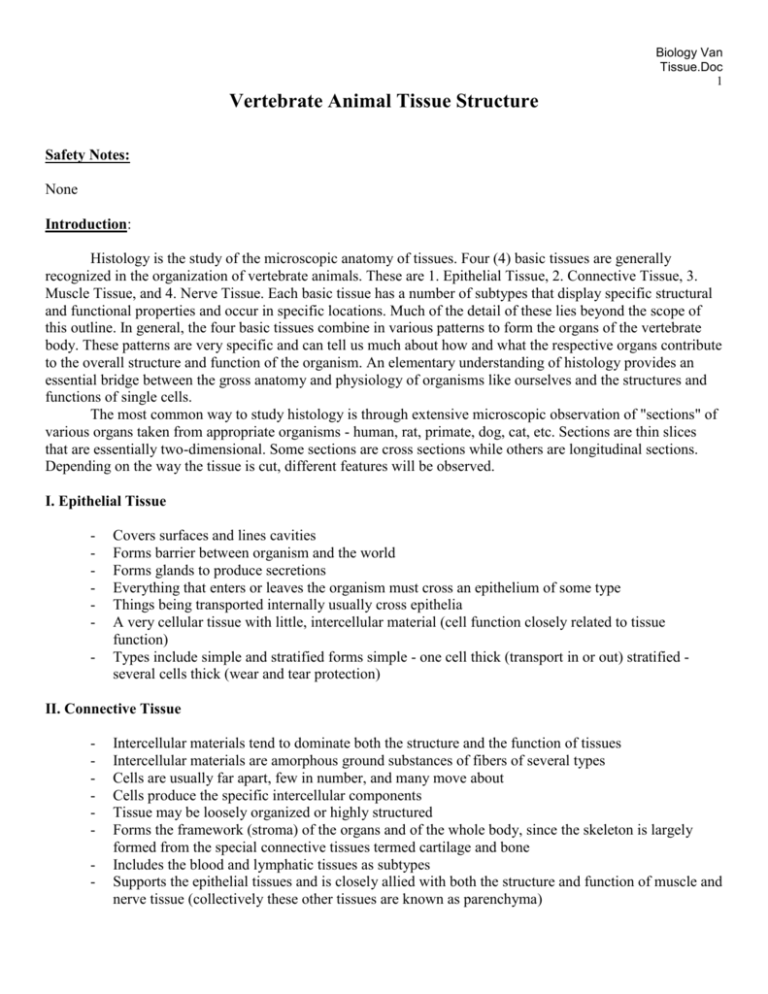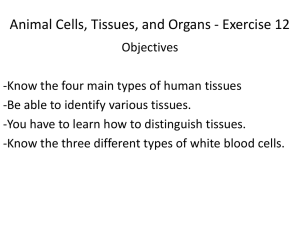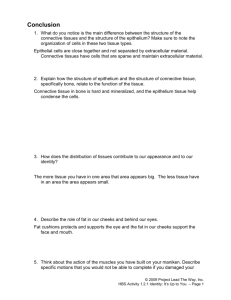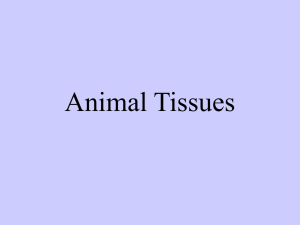Vertebrate Animal Tissue Structure
advertisement

Biology Van Tissue.Doc 1 Vertebrate Animal Tissue Structure Safety Notes: None Introduction: Histology is the study of the microscopic anatomy of tissues. Four (4) basic tissues are generally recognized in the organization of vertebrate animals. These are 1. Epithelial Tissue, 2. Connective Tissue, 3. Muscle Tissue, and 4. Nerve Tissue. Each basic tissue has a number of subtypes that display specific structural and functional properties and occur in specific locations. Much of the detail of these lies beyond the scope of this outline. In general, the four basic tissues combine in various patterns to form the organs of the vertebrate body. These patterns are very specific and can tell us much about how and what the respective organs contribute to the overall structure and function of the organism. An elementary understanding of histology provides an essential bridge between the gross anatomy and physiology of organisms like ourselves and the structures and functions of single cells. The most common way to study histology is through extensive microscopic observation of "sections" of various organs taken from appropriate organisms - human, rat, primate, dog, cat, etc. Sections are thin slices that are essentially two-dimensional. Some sections are cross sections while others are longitudinal sections. Depending on the way the tissue is cut, different features will be observed. I. Epithelial Tissue - Covers surfaces and lines cavities Forms barrier between organism and the world Forms glands to produce secretions Everything that enters or leaves the organism must cross an epithelium of some type Things being transported internally usually cross epithelia A very cellular tissue with little, intercellular material (cell function closely related to tissue function) Types include simple and stratified forms simple - one cell thick (transport in or out) stratified several cells thick (wear and tear protection) II. Connective Tissue - Intercellular materials tend to dominate both the structure and the function of tissues Intercellular materials are amorphous ground substances of fibers of several types Cells are usually far apart, few in number, and many move about Cells produce the specific intercellular components Tissue may be loosely organized or highly structured Forms the framework (stroma) of the organs and of the whole body, since the skeleton is largely formed from the special connective tissues termed cartilage and bone Includes the blood and lymphatic tissues as subtypes Supports the epithelial tissues and is closely allied with both the structure and function of muscle and nerve tissue (collectively these other tissues are known as parenchyma) Biology Van Tissue.Doc 2 III. Muscle Tissue - A tissue is dominated by its cells, but it could not function without the associated connective tissues A tissue specialized for contraction Cells may remain individual or may fuse to form larger contractile units (still called "cells" or fibers) Where fusion has occurred, fibers are multinucleate Fibers are elongated Contractile myofibrils usually show elaborate fine structure which is visible as cross "striations" Important association with connective tissues and nerve tissue to form functional muscle Three subtypes in vertebrates -- smooth, skeletal, cardiac IV. Nerve Tissue - - The tissue is dominated by the cells which comprise it Cells specialized for conduction, synaptic association, and secretion of neurohumors (neurons) Neurons reside only in highly specific locations (gray matter of CNS and ganglia of PNS) and make synaptic connections with all areas of the body by sending out specialized cytoplasmic processes known as axons - axons can be very long and they always end in a synaptic connection to either another neuron, a sensory structure, or an effector (muscle or gland) Other extensions of the cell provide extra surface for synaptic connections known as dendrites The part of the cell which is neither axon or dendrite is termed the cell body and houses the nucleus and other major cellular organelles Neurons may function as sensory, motor, or associative components of the nervous system Cell types other than neurons are very abundant and associate in very specific ways with neurons and/or the axons (glial cells, neurilemma and satellite cells) Associated cells have important functional roles only some of which are understood Nerves of gross anatomy consist of bundled axons, neurilemma cells, and associated connective tissues (no cell bodies unless a ganglion is present) Histology of nerve tissue is difficult to understand without a good sense of the gross anatomy of the nervous system Nerve tissue is closely allied with muscle tissue, connective tissue and even epithelial tissue in the overall structure of the vertebrate organism. Objectives: 1. Each student will observe, identify and draw diagrams of the four tissue types in prepared slides of animal organs. 2. Each student will explain the organization and relationship of cells, tissues, and organs in an animal. Materials: Lens paper Microscopes Videoscope and monitor Colored pencils Class set of simple squamous epithelium slides Class set of neuron motor slides Class set of smooth motor muscles Biology Van Tissue.Doc 3 Class set of tongue slides Procedure: 1. Each student has his/her own microscope and the teacher leads the observations with the videoscope. 2. Focus on a simple squamous epithelial slide magnified 40X. This slide is a section of kidney. A. Locate and identify the simple squamous epithelial cells lining the top and bottom edges of the section. B. Locate and identify the simple cuboidal epithelial cells lining the tubules in the kidney. C. Draw and label a small section showing both epithelium. 3. Focus on a neuron motor slide magnified 100X. This slide was prepared by streaking spinal cord; notice the tissue is smeared on the slide. This is not a slide of nerve tissue. A. Locate and identify a neuron. Try to focus on a cell body and it's nucleus. What is the stringy material on the slide? B. Draw and label a neuron. 4. Focus on a smooth muscle slide magnified 40X. This is a cross-section of a small intestine. Notice the many feather-like projections, called villi, lining the inner cavity. Hypothesize as to the purpose of these structures. A. Focus at 100X magnification. Slowly move the slide from the outer edge of the intestine through the center to the other edge. How many different tissue types do you observe? B. Notice the wide, pink layer of tissue around the outer edge. This is muscle tissue. C. Notice the lighter pink layer of tissue between the muscle and the villi. This is connective tissue. What is the distinctive characteristic of connective tissue? D. Focus at 40X magnification on the cells lining villi. What type of tissue is this? E. Draw a small section at 100X magnification and label the three types of tissue. 5. Focus on a tongue slide magnified 40X to overview the section, then focus at 100X magnification. A. Notice the dark purple tissue lining the surface of the tongue. What type of tissue is this? B. Notice the lightly stained sacs embedded in the epithelium. These are the taste buds. C. Notice the sacs at the bottoms of the epithelial indentations. These are salivary glands. D. Notice the disorganized tissue just below the epithelium and salivary glands. This is loose connective tissue. E. The remaining tissue is muscle. Depending upon the cut, the muscle looks like steak. F. Draw a small section at 100X magnification and label the tissues and taste buds. Biology Van Tissue.Doc 4 Evaluation: Lab Report Names: Title: Date: Objective(s): 1. Each student will observe, identify and draw diagrams of the four tissue types in prepared slides of animal organs. 2. Each student will explain the organization and relationship of cells, tissues, and organs in an animal. Observations: Biology Van Tissue.Doc 5 Discussion: 1. What magnification is the best for the observation of tissue slides? Explain why 2. Refer to your observations on the tongue slide and explain the relationship between cells, tissues, and organs. Biology Van Tissue.Doc 6 3. Why did we not notice nerve tissue in the tongue and intestine slides? Biology Van Tissue.Doc 7 Mark A. Nale 8-28-95 IBM - AnHisSli Animal Histology Vertebrate Animal Tissue Slides Lesson Plan - Day One Materials 1. Use black board for drawings and notes on cell characteristics. 2. Show slide of that cell type on the screen. 3. Show microscope slide on video microscope. 4. Have students use microscopes and prepared microscope slides 5. Circulate to check on and help students. 6. REPEAT FOR EACH CELL TYPE. Video microscope Microscopes Slide projector Slides in a slide tray Prepared microscope slides 1. (#7 Ep Tissue Set) Stratified (layered) Squamous - thick skin - epidermis Epidermis, the outer covering of skin, is stratified squamous keratinizing epithelium and is supported by connective tissue of the dermis. The duct of a sweat gland is shown. 2a. (#16 Ep Tis) Simple Columnar Epithelium - colon - goblet cells (white) One cell layer thick. Lines intestines - absorbs water and/or nutrients. Goblet cells make mucus. There is enough area of columnar epithelium in the human small intestine to cover a football field. Smooth muscle shown beneath the epithelium. 2b. (#13 Ep Tis) Columnar Epithelium & Goblet Cells - small intestine The small intestine is lined by simple columnar epithelium (enterocytes) with ovoid nuclei and with a brush border. Numerous goblet cells are present in the epithelium; these are unicellular glands that secrete a protective lubricating mucus. 2c. (#5 Ep Tis) Simple Columnar Epithelium - seminal vesicle The lining mucous membrane of the seminal vesicle is composed of loose areolar connective tissue, the lamina propria, and simple columnar epithelium, and it is complexly folded. Nuclei are basal. 3 (#12 Ep Tis) Ciliated Columnar Epithelium - an air passage way Ciliated columnar epithelium lines the air passages, lungs, uterus, and vagina. Cigarette smoking destroys cilia in lungs and trachea that normally Biology Van Tissue.Doc 8 remove mucus, etc. from lungs. Smokers must cough out this material. Smokers Cough!! 4. (#4 Ep Tis) Cuboidal Epithelium - Kidney Box or cube-like cells. They form the ducts in the liver and kidneys. In the center of the slide a kidney duct (xs) is formed by cuboidal epithelium. Cells have large round nuclei. 5a. (#1 Muscle Tis) Skeletal Muscle - voluntary - striated Cells look like long logs, scattered nuclei, cell membranes not clearly visible. Striations are "stripes" that run across cells. Two Muscle Cell Types Fast Twitch - (white meat) more calogen (grouse breast, good sprinters) Slow Twitch - (dark meat) weight lifters, cross-country runners. These muscle types stain differently. Most muscles are a mixture of these two types. 5b. (#3 Mus Tis Set) Skeletal Muscle - striated 5c. (#4 Mus Tis Set) Skeletal Muscle - striated 6a. (#15 Mus Tis Set) Cardiac Muscle Same as skeletal except for: These muscle fibers are not attached to bone and therefore must have a strong connection to each other - intercalated disks (a zigzag fibrous connection that holds cells together. Gap junctions -"holes" in side-by-side cell membranes - allows cells to communicate with each other. 6b. (#11 Mus Tis Set) 7 (# 16 Mus Tis Set) Cardiac Muscle Smooth Muscle of Duodenum (intestine) In this longitudinal section of the gut, the inner layer of muscle is cut transversely and the outer layer longitudinally, with connective tissue between the layers containing blood vessels and a small nerve. No striations, elongated cells. Found: intestinal muscles, uterus, and the sphincter muscles around blood vessels. 8. (#15 Con Tis Prop) FAT adipose tissue A thin rim of cytoplasm (red) surrounds the large fat globule, which has been dissolved in the preparation. Occasional nuclei (blue), with distinct nucleoli, may be seen within the rim of the cytoplasm. Fat cells look Biology Van Tissue.Doc 9 hollow because cells are filled with one big food vacuole. We fill these vacuoles when we gain weight. A genetic program sets the number of fat cells in your body. If cells are removed by liposuction, the body will grow new cells to replace the ones that are lost. Nerve Cells & Bone Cells Lesson Objectives 1. The learner will be able to recognize these 10 tissue types. 2.'The learner will be able to match characteristics with tissue types. 3. The learner will be able to explain how the shape of the cells is matched to their function. 4. The learner will be able to relate some applied knowledge as it relates to fat cells & body weight, smoking & ciliated columnar epithelium, and muscle type & physical activity.









